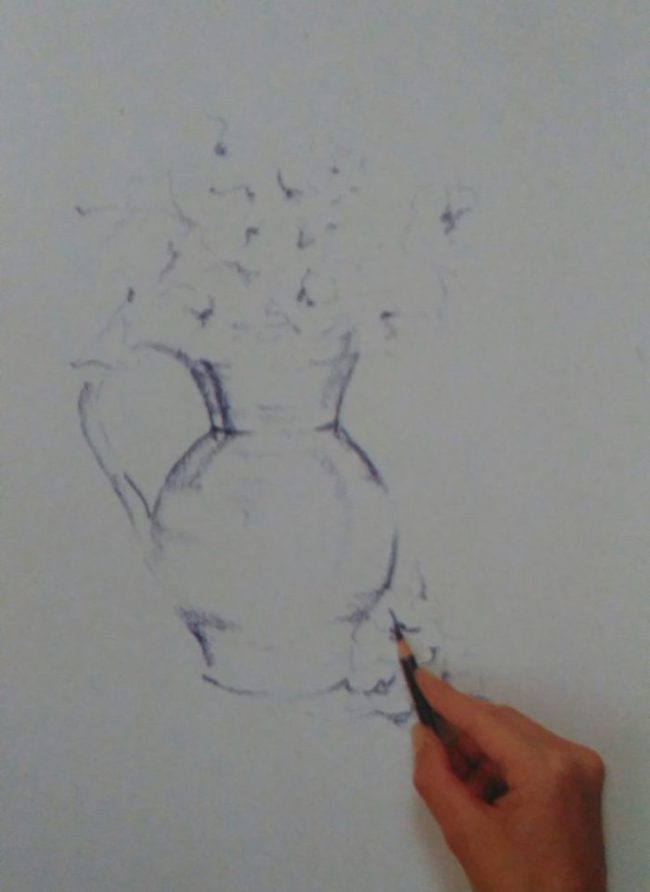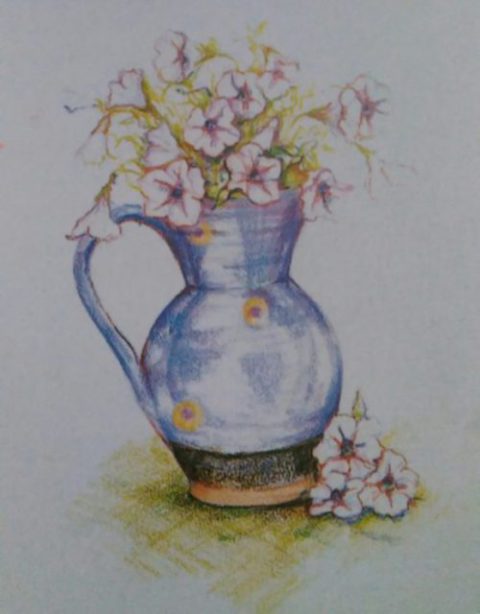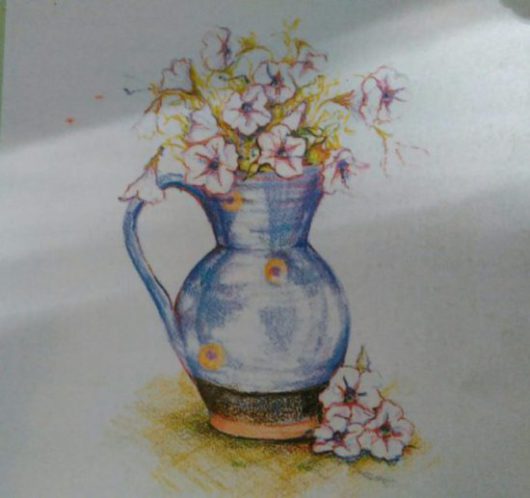Pigments used for producing coloured pencils are semi-transparent, light reflects of the white surface of the paper and goes through the colours giving them slight luminescence. The lead of the pencil consists of clay coloured with pigment and binder as wax or oil. Pencils containing oil binder are of a much better quality so try working with them. The more wax the pencil contains the harder it is, therefore, you should try various sets of pencils to determine which suits your technique the best.
With soft pencils, you can create mild even spreads of colour, hard pencil leaves a thin coloured trace and its suitable for making fine precise lines. Many artists use both kinds of coloured pencils for getting various effects
In order to get lively, shiny look you should use the side of the pencil lead and apply a lot of pressure to rub it into the surface of the paper. You can also enhance the brightness of the colour by rubbing it with your finger, rag or a piece of paper.
Mixing The Colours
If you want to give your drawing a nicer more realistic look, you can use several techniques of mixing colours like hatching, cross-hatching and scratching of the layers of colour. For example, blue colour added over yellow makes much nicer green when looking from afar than if you use just the plain green colour. When using pastels the best thing to do is to make colours gradually by adding mild separate lines on the paper leaving the whiteness of the paper in between.
Hatching and cross hatching is the best way to get that effect because fine straight lines allow you maximum control of the outcome.
Drawing Of Petunias In A Vase
You will need the following
- A sheet of natron paper
- Sky blue
- Dark blue
- Purple
- Dark purple
- Light pink
- Dark green
- Yellow-green
- Sepia
- Cinnamon colour
- Gold
- Wine red

Sketching
Start the drawing by sketching the shapes of the composition with the tip of properly sharpened sky blue pencil. Make sure that the lines are very thin. When you finished drawing the basic shapes of the vase take a darker blue pencil and use it for emphasizing the dark areas on the vase, draw with the side of the lead to make nice soft tones. Use the same pencil to draw the middle of the flowers. Keep adding lines on the contours of your drawing. In that way, you are building your drawing giving it depth and a more realistic look.
Continue working on the flowers with a purple pencil. Again use the side of the pencil lead to get softer tones. Start colouring from the centre of the flowers and gradually build the colour with the side of the pencil lead. Colour the space between the flowers with the purple colour to separate and emphasize on the petals. Also, use the purple colour on the vase adding it over dark blue to create the tones and shades.


Starting To Give Life To Your Drawing
Use the side of the lead of the pink colour to colour the petals and the tip of the pencil to outline the rim of the petals and delicate lines on the petals, also add some pink colour to the vase. With dark purple colour lightly over the petals and between the flowers to make the shades look darker and to separate the flowers even more. Colour with it over the centre of the flowers to gain the crimson pink nuance.
For the leaves between the flowers use a dark green colour and yellow-green. With the dark green draw the pattern of circles on the vase and draw the shade of the vase and the fallen flowers on the green tablecloth.
Work on the circular patterns with pale pink over which you’ll add gold. For the centre of the circle use purple colour. To emphasize the round shape of the vase use sky blue colouring with wide strokes of the pencil. Leave areas of clean white paper to get the impression of light reflecting on its surface.


Finishing Touches
Draw a dark line all around the vase with sepia and use cinnamon colour for the base of the vase. With wine red create deeper shades on the vase, on the handle and on the edges. Using the same colour work on the contour of the flower petals and the contour of the fallen flowers.
Finish your drawing by adding the shade on the tablecloth using a light green colour, apply the colour using the side of the pencil lead. Add more leaves and stems between the flowers using green colour and more pale pink colour on the petals in the background. You can always emphasize on the details using the pencil tip of a certain darker colour.
This is one of many ways of using coloured pencils. In time you will find the technique you prefer. If you have any questions or comments feel free to leave them below and I will be more than happy to answer.





WOW, this is an amazing article. I actually found this to be more of a mini-tutorial.
I am brand new to the art world, and I have bookmarked your article. I have learned so much from just this one article alone.
Tell me in your opinion, what would recommend the best brand of pencil colors to use?
Thanks for an awesome and helpful article.
Thank you for your comment
So glad to hear you found it educational. My personal favourite is Faber Castel Polychromos, but there are so many good coloured pencils, all depends on what suits you the best.I’ll make sure to cover several good ones on my website so you can choose one.
Hey,
really found this article interesting, I have always been amazed at the work artists do and how much detail people go into.
Really found it useful to know how people create amazing work with pencils!
Thank you!